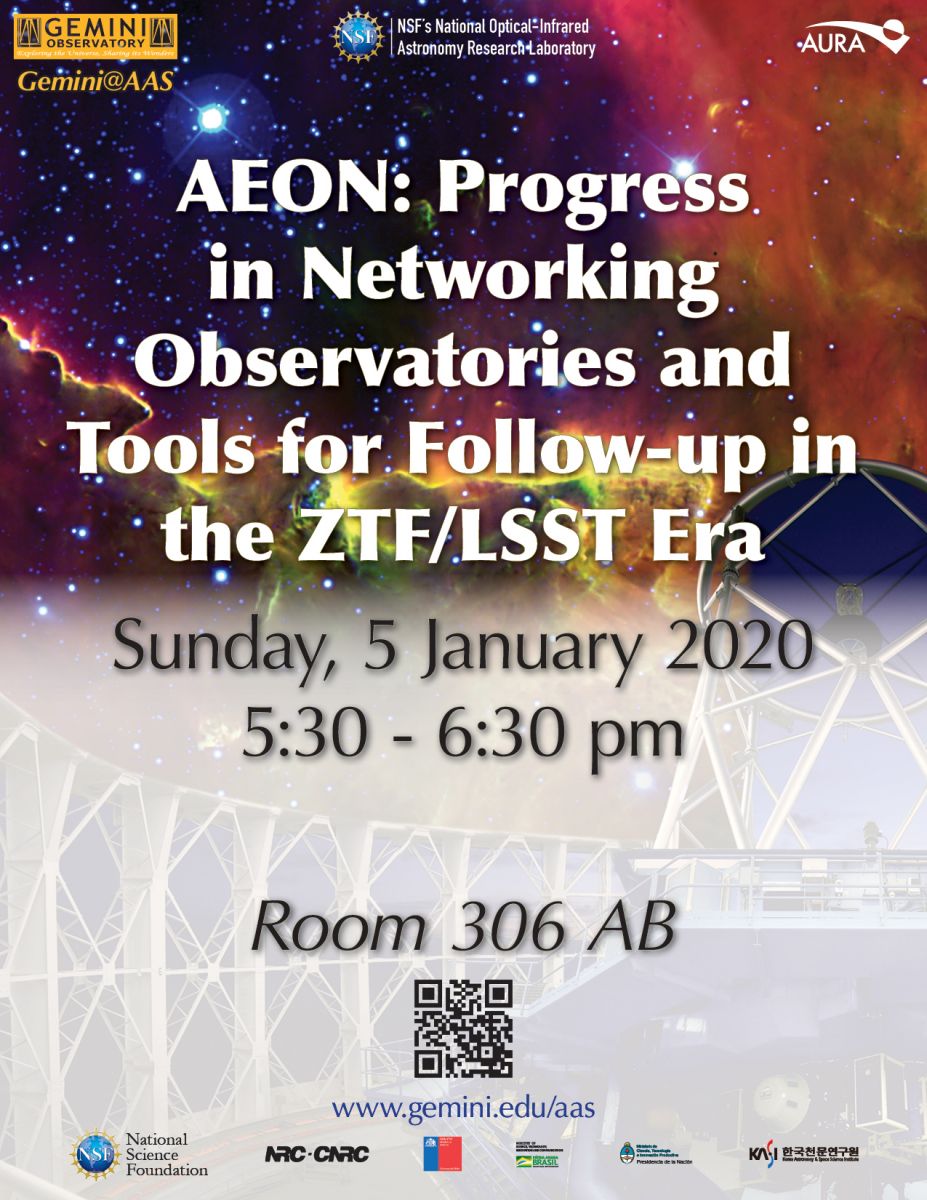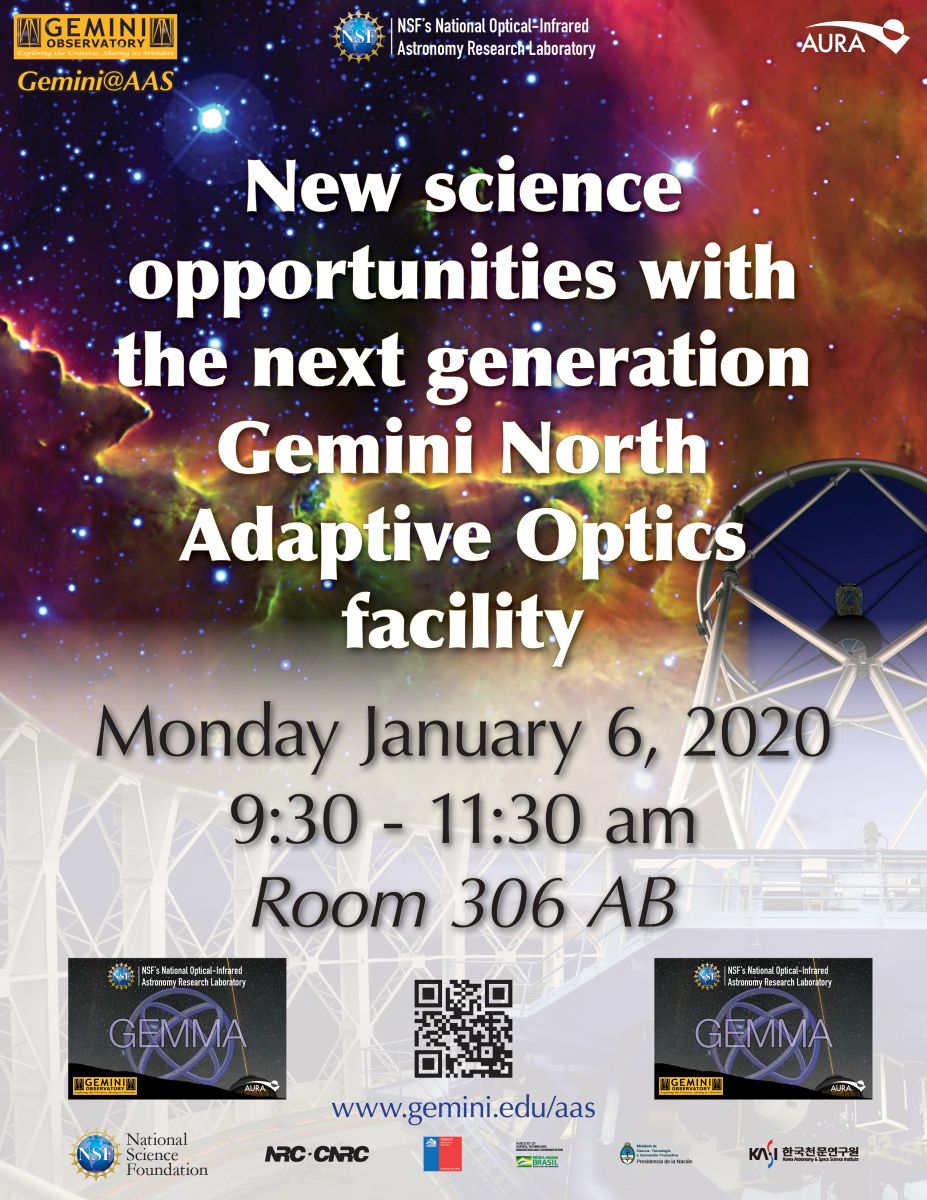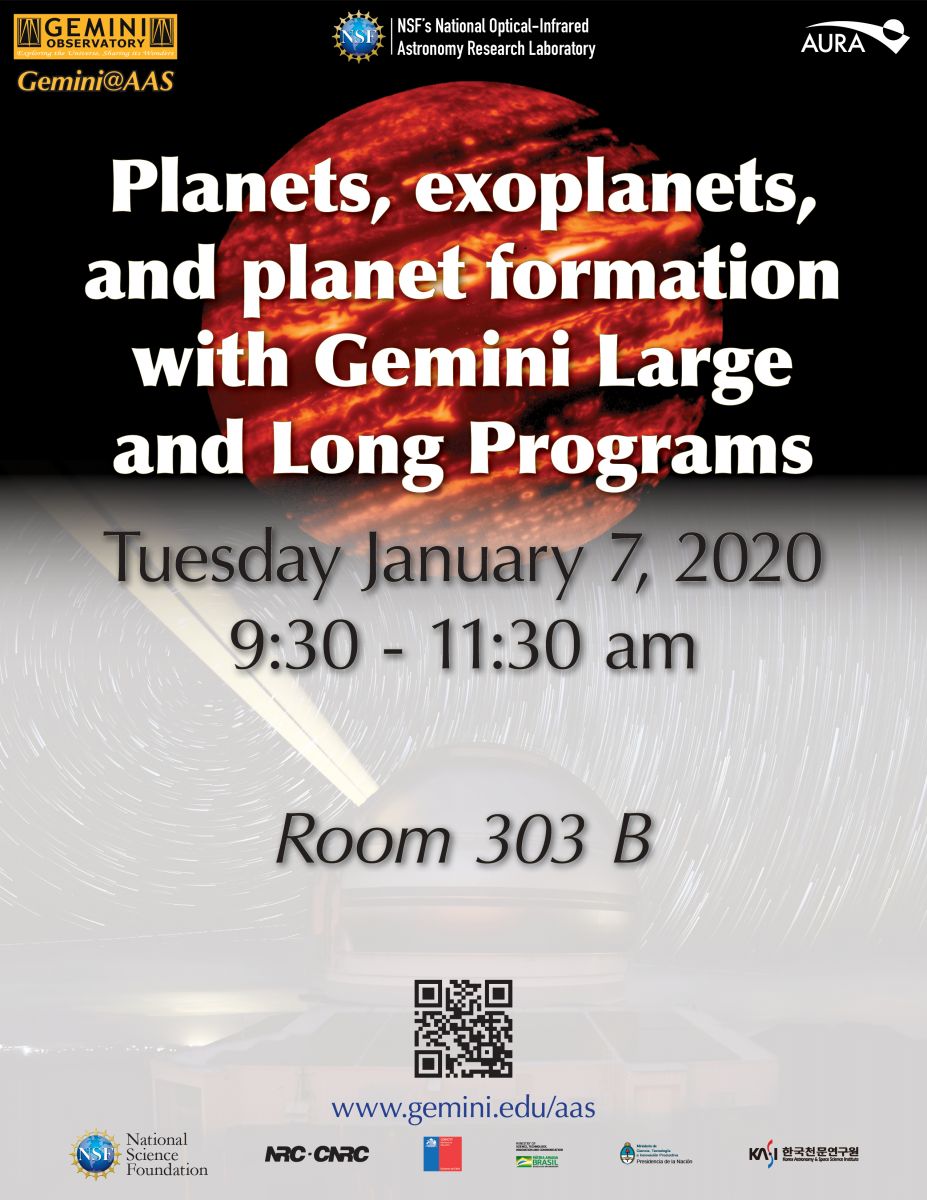Gemini Observatory and its partners will have many events at the 235th meeting of the American Astronomical Society (AAS), hosted this year in Honolulu, Hawai'i during 4–8 January 2020.

Visit the Gemini Observatory Booth in the Exhibit Hall at any time!
The Gemini Booth will be situated on the NSF carpet, between the National Solar Observatory and the Large Synoptic Survey Telescope booths. Come to:
- Get the freshest news about the Gemini Observatory
- Get personal support for a proposal, an active program and/or Gemini data reduction
- Get your own deck of the Gemini Card Game!
- Look at our job opportunities
- And more...
Gemini Observatory Open House
Tuesday January 7, 2020: 6:00 pm-7:00 pm, Hawaiʻi Convention Center, Room 304 AB
 |
Gemini Observatory invites the community to learn about the latest opportunities for a broad range of science with Gemini’s twin 8.1 m telescopes located on Cerro Pachón in Chile and Maunakea in Hawai‘i. Gemini’s agile queue operations, broad suite of optical and infrared facility and visiting instruments, and diverse proposal opportunities support a variety on-going programs, including time-domain astronomy, high-spatial and high-spectral resolution studies, exoplanets, and extragalactic astronomy. We will present the key points of our recently released Strategic Scientific Plan for Gemini Observatory and provide an update on the Gemini in the Era of Multi-Messenger Astronomy (GEMMA) Program. The GEMMA Program is funded by a major new award from the National Science Foundation in support of two central elements of our Strategic Plan: a state-of-the-art wide-field AO system for Gemini North, and improvements to the Observatory’s ability to respond rapidly to transient events in the time-domain era and quickly deliver science-ready data to our users. We will describe progress on Gemini’s facility instruments now under development: GHOST, a high-throughput, high-spectral resolution (R~50-75,000) spectrograph with continuous coverage at 0.36-0.95 microns; and SCORPIO, an 8-channel optical/IR imager and spectrograph with simultaneous coverage from 0.38-2.5 microns. In addition, two new facility instruments are in their early design stages: GNAOI and IGRINS-2 (both tentative names). GNAOI will be a new infrared imager to accompany our new adaptive optics system and Gemini North while IGRINS-2 is an update of the successful visitor instrument, IGRINS, being built for Gemini by the Korea Astronomy and Space Science Institute. We will also describe our Visiting Instrument and instrument upgrade programs and opportunities for the community to engage with Gemini development efforts. Additionally, we will discuss our education and outreach in our local communities in Hawai‘i and Chile. |
AEON: Progress in Networking Observatories and Tools for Follow-up in the ZTF/LSST Era
Sunday January 5, 2020: 5:30 pm-6:30 pm, Hawaiʻi Convention Center, Room 306 AB
|
We will present the first science results and technical achievements in the development of the Astrophysical Events Observatories Network (AEON). The initial AEON partner observatories are the Gemini, Las Cumbres, NOAO, and SOAR. We will discuss how observation requests for the SOAR 4.1m can now be programmatically submitted and queue-scheduled through the LCO network infrastructure, thanks to recent upgrades at both facilities, and how this enables a range of science. We will demonstrate the advantages offered by Target and Observation Manager systems (TOMs) in optimizing any observing program. LCO has developed the TOM Toolkit package to make it easy for astronomers to build a TOM for their own science, and we will update the community on the new functionality offered by the TOM Toolkit, including built-in interfaces for a number of observing facilities, brokers and data archives. |
 |
New science opportunities with the next generation Gemini North Adaptive Optics facility
Monday January 6, 2020: 9:30 am-11:30 am, Hawaiʻi Convention Center, Room 306 AB
 |
As part of the “Gemini In The Era of Multi-Messenger Astronomy (GEMMA)” program, funded by a multi-million dollar award from the National Science Foundation, Gemini is designing a new queue-operated multi-conjugate adaptive optics (AO) facility for the 8-m Gemini-North telescope. By delivering an AO-corrected field-of-view of 2 arc minutes to feed the next generation of AO-assisted Gemini-North instruments, GNAO will enable a broad range of science cases. Please join us to learn about the GNAO project and future opportunities for scientific exploration with the GNAO facility. Chair: Julia Scharwächter9:30 Gaetano Sivo |
Planets, exoplanets, and planet formation with Gemini Large and Long Programs
Tuesday January 7, 2020: 9:30 am-11:30 am, Hawaiʻi Convention Center, Room 303 B
|
This splinter session focuses on recent solar system and exoplanet science from the Gemini large and long program (LLP). Gemini large and long proposals can be submitted on any topic. However, recently a number of proposals have been on solar system and exoplanet astronomy. A variety of these programs will be reviewed in 20 minute talks during this session. The planned range of topics includes observations of planet formation, characterization of dusty, rocky, and icy debris in the solar system and in exoplanetary systems, and investigations of the structure of exoplanet atmospheres. The programs use a variety of Gemini instrumentation including GMOS, GPI, and AO imaging. |
 |
An Evening with the Maunakea Observatories
Tuesday January 7, 2020: 7:00 pm-9:00 pm, Hawaiʻi Convention Center, Room 323 A
 |
Please join us for a panel discussion by the Directors of the Maunakea Observatories to discuss the present and future of astronomy on Maunakea. |
List of Talks and Posters
Your contribution presents Gemini related work and it is not listed here? Please send details to sus_inquiries@gemini.edu.
----
Sunday, 5 Jan
Posters
| ID | 1st author | Title |
| 175.23 | J. Scharwächter | The next-generation Gemini North Multi-Conjugate Adaptive Optics Facility |
| 105.05 | A. Nitta | Search for DBVs with Gemini Observatory’s ‘Alopeke |
| 175.22 | G. Mace | IGRINS Returns to Gemini South |
| 104.08 | A. Grace | Place Based Education for Teaching Astronomy in Hawaiʻi |
| 105.02 | C. McDermott | The Dry Crust of a Rocky Planet Being Accreted by the White Dwarf SDSSJ073110.35+241704.2 |
| 110.05 | C. Sneden | High-resolution Infrared Spectroscopy of Open Cluster NGC 752 |
| 111.03 | O. Cooper | Lensing Masses of 8 Planck-selected Gravitationally Lensed Sub-millimeter Galaxies |
| 170.21 | C. Vides | Constraining the Orbital Period of SN2010da |
| 174.01 | T. Cook | Detecting transiting exoplanets with a low-cost robotic telescope system |
Talks
| ID | Time | 1st author | Title |
| 135.01 | 10:00-10:10am | T. Currie | TMT in the Community: Addressing Common Misconceptions and Seeking Common Ground |
| 135.02 | 10:10-10:20am | L. E. Chu | TMT in the Community: Cultural and Educational Initiatives by the Thirty Meter Telescope |
| 135.03 | 10:20-10:30am | J. K. Chu | TMT in the Community: Investing in the Future of Hawai`i |
| 135.07 | 11:00-11:10am | S. Durst | Astronomy from the Moon: Hawai'i 21st Century Astrophysics |
| 130.08 | 11:10-11:20am | J. C. Mather | Ground-Space Partnership: ELTs with orbiting guidestars and orbiting starshades |
| 161.04 | 2:40-3:00pm | A. Steele | Connecting circumstellar gas around white dwarfs to small bodies in the solar system |
| 161.05 | 3:00-3:10pm | S. Silverberg | Four New Peter Pan Disk Candidates from Disk Detective |
Monday, 6 Jan
iPosters
| ID | 1st author | Title |
| 215.04 | S. Margheim | The Gemini High-Resolution Optical Spectrograph |
| 216.01 | P. Kalas | HST/STIS coronagraphic imaging of newly resolved debris disks around young stars |
| 217.01 | G. C. Clayton | Dust Formation in the Type II Supernova, 2007oc |
Posters
| ID | 1st author | Title |
| 280.02 | E. L. Nielsen | The Gemini Planet Imager Exoplanet Survey: Giant Planet and Brown Dwarf Demographics from 10-100 AU |
| 274.14 | J. E. Andrews | Spectra of Eta Car before the Great Eruption |
| 204.16 | K. Chiboucas | The Search for UCDs in the Coma Cluster |
| 205.12 | M. S. Thompson | “Metallicity Diagnostics of Galaxies in the CGM2 Survey” |
| 207.38 | D. Carr | Compaction in Action: Tracing the Formation and Evolution of Blue and Red Nuggets at Redshift Zero in the RESOLVE Survey |
| 208.27 | J. Antwi-Danso | Exploring the Formation of Massive Galaxies at 4 < z < 6 Using Novel K blue and K red Filters |
| 214.02 | M. Jeong | Chemodynamical Properties of Extremely Metal-Poor Stars |
| 274.11 | R. Siverd | Dynamical Masses and Radii of Eclipsing Giants Discovered by KELT |
| 281.06 | H. Leiendecker | Characterizing Structure in Protoplanetary Disks with Gaps |
| 281.07 | T. Dupuy | Which Binaries Foster Planet Formation and Survival? |
Talks
| ID | Time | 1st author | Title |
| 254.03 | 2:20-2:30pm | K. Ward-Duong | Gemini Planet Imager Spectroscopy of the Dusty Substellar Companion HD 206893 B |
| 231.04 | 10:40-10:50am | R. A. Dupke | Shedding Light on the Age of Fossil Groups with the ICL |
| 252.02 | 2:10-2:20pm | A. Shugart | Assembling the knowledge of best practices in diversity, equity, and inclusion to develop a structure for an astronomy organization |
| 225.04 | 10:40-10:50am | J. Bean | Following up TESS's temperate terrestrials with MAROON-X |
| 252.03 | 2:20-2:30pm | T. Spuck | Astronomy in Chile Educator Ambassadors Program |
| 256.08 | 3:20-3:30pm | S. T. Douglas | The impact of companions on the rotation of Praesepe early M dwarfs |
Tuesday, 7 Jan
iPosters
| ID | 1st author | Title |
| 381.06 | B. Matthews | Gemini Near Infrared Spectrograph Distant Quasar Survey: Initial Results |
| 314.02 | T. Pyo | Extended H2 and [Fe II] emission structure around VV CrA binary system |
| 377.08 | W. M. Best | Probing the Low-Mass End of the Initial Mass Function with an HST DASH Survey of Star-Forming Regions |
| 381.05 | D. M. Crenshaw | Feeding and Feedback on Nuclear and Galactic Scales in the Seyfert 2 Galaxy Mrk 3 |
Posters
| ID | 1st author | Title |
| 307.10 | S. Coffin | Optical Identification and Spectroscopy of Supernova Remnants in M51 |
| 308.08. | Y. Ma | Potential Influence of Stellar Flybys on the Morphology of Debris Disks in the Scorpius-Centaurus Association |
| 308.15 | S. Wolff | The Peculiar Morphology of the Gas-rich Circumstellar Disk Wray 15-788 |
| 308.21 | J. Patience | A Survey for Resolved Debris Disks in Sco-Cen |
| 310.06 | T. R. Geballe | Warm diffuse outflowing gas in the Galactic center revealed by spectroscopy of H3+ |
| 371.07 | M. Hussaini | The First IFU Spectroscopic View of Shocked Cluster Galaxies |
Talks
| ID | Time | 1st author | Title |
| 325.07 | 11:10-11:20am | J. P. Madrid | Optical study of PKS B1322-110, the intra-hour variable radio source |
| 322.01 | 10:00-10:10am | J. K. Chu | Probing the ISM of Dusty, Luminous Infrared Galaxies at Cosmic Noon |
| 326.07 | 11:10-11:20am | A. Rest | The historic light curve of Eta Car from light echoes |
| 352.04 | 2:30-2:40pm | J. Vos | Young L Dwarf Variability in the Mid-IR |
Gemini Observatory Open House
Wednesday, 8 Jan
Posters
| ID | 1st author | Title |
| NA | NA | NA |
Talks
| ID | Time | 1st author | Title |
| 437.06 | 2:50-3:00pm | A. J. van der Horst | Probing the Transient Sky with SCORPIO on Gemini |
| 415.04 | 10:40-10:50am | M. Andersen | Reaching the low-mass content in Young Massive Star Clusters Using Multi Conjugate Adaptive Optics |
----
Your contribution presents Gemini related work and it is not listed here? Please send details to sus_inquiries@gemini.edu..